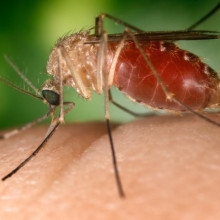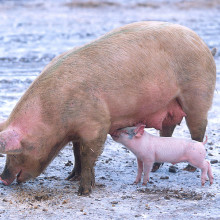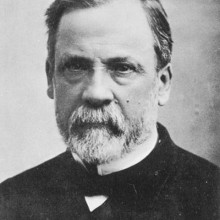In this NewsFlash, we find out why dolphins spit for their dinner, how every cloud may have a lead lining and how the pesky mosquito's inspired a portable artificial pancreas. Plus, we get the low-down on the latest pandemic candidate - swine flu, and discover how Louis Pasteur first presented his evidence for "Germ Theory" this week in 1878.
In this episode

Mosquito-inspired bloodsucker paves way towards artificial pancreas
A new high-tech gadget inspired by the humble mosquito could one day provide diabetic patients with a portable, artificial pancreas that will painlessly monitor and control their blood sugar levels.
The Electronic Mosquito, or e-mosquito, was invented and patented by Martin Mintchev and Karen Kaler, electrical engineers from the University of Calgary in Canada.
 Modelled on the piercing, sucking mouthparts of mosquitoes, the e-mosquito device is currently about the size of a deck of cards and contains four micro-needles, which are about twice the diameter of a human hair. By carefully controlling the movement of the needles, they can delicately penetrate the skin just far enough to draw blood from shallow capillaries while avoiding nerves that are deeper in the skin, so the patient does not feel a thing.
Modelled on the piercing, sucking mouthparts of mosquitoes, the e-mosquito device is currently about the size of a deck of cards and contains four micro-needles, which are about twice the diameter of a human hair. By carefully controlling the movement of the needles, they can delicately penetrate the skin just far enough to draw blood from shallow capillaries while avoiding nerves that are deeper in the skin, so the patient does not feel a thing.
The needles draw a tiny drop of blood - less than a millilitre - but that is enough for a lab-on-a-chip sensor in the device to measure blood sugar levels. It then sends the information wirelessly to a computer or a monitoring instrument worn on the wrist. It could be hooked up to an alarm to warn the patient or doctor that blood sugar levels are reaching dangerous levels.
Mintchev and Kaler now hope to start working towards making the gadget much smaller, until perhaps it resembles a regular sticking plaster or band-aid, and then diabetic patients would be able to monitor their blood sugar painlessly and effortlessly throughout the day.
The idea is eventually to link the e-mosquito to a device that can administer insulin - that vital hormone that diabetics lack which regulates blood sugar levels - and essentially create an artificial pancreas that not only monitors the amount of glucose in the blood but also automatically delivers the correct dose of insulin. The e-mosquito could soon offer hope to some of the 246 million people worldwide who suffer from diabetes and for whom needles and painful, time-consuming blood tests are still part of every day life.

Every cloud has a silver lining, or should that be a lead lining?
We could have inadvertently stalled the greenhouse effect by historically including lead in petrol, a European and US team of scientists have concluded.
Writing in the current edition of Nature Geosciences, Ulrike Lohmann and her colleagues show that lead is one of the most potent water droplet-forming agents in the atmosphere.
Clouds form when rising warm wet air expands sufficiently to cool, allowing water molecules to coalesce. At very low temperatures they can do this spontaneously but usually this occurs at much higher temperatures because the water molecules begin to cluster around particles of dust, pollen and even dandruff and bacteria. These particles are collectively known as nucleation sites, and lead is the king.
The team made the discovery by sampling clouds collected in Switzerland and also by recreating clouds in the laboratory using ambient air samples. When they fed their cloud samples into an analyser they found that the majority of the water droplets were associated with lead particles. Presumably the chemistry of lead makes it an ideal rain-maker, but the implication of the research is that by choosing to lubricate the valves of engines by adding lead to petrol we may have made a significant different to global weather and global warming.
The lead particles, say the scientists, could have triggered increased cloud formation by boosting the effectiveness of nucleating particles in the air. And because clouds reflect heat back out into space, this could have kept the Earth artifically cool despite rising CO2 levels. The effect, say the researchers, could have been sufficient to send back out to space nearly 1W per square metre that would otherwise have hit the ground and warmed the Earth. But now that we've eschewed lead in favour of a healthier atmosphere we may be about to reap the costs of the CO2 seeds we've sown in the past...

Down Under Dolphins spit for their dinner
Spitting at the dinner table may be the height of bad manners for us humans, but in the dolphin world it is quite acceptable.
 Researchers from the World Wide Fund for Nature, (WWF) have recently discovered that rare snubfin dolphins from down under get together in groups and spit for their dinner.
Researchers from the World Wide Fund for Nature, (WWF) have recently discovered that rare snubfin dolphins from down under get together in groups and spit for their dinner.
The snubfin is a strange-looking dolphin, at around 6 feet long, with a melon-shaped head and short stubby fins. Very little is known about this rare species, the only endemic dolphin species in Australia, which was discovered in 2005; until then the Australian populations were thought to belong to another species, the Irrawaddy dolphin, which lives in rivers of southeast Asia.
Now scientists have begun to unpick some of the secrets of these mysterious dolphins, and have seen them hunting in groups of 6 or more. Working together, some dolphins will chase fish towards the sea surface and then herd them towards other dolphins by spitting out jets of water from their mouths. Sometimes they shoot out plumes of water high into the air and other times will spit straight ahead just above the sea surface.
Sadly just as scientists are beginning to uncover more about their bizarre lives, the snubfin dolphins are coming under increasing pressure and are extremely threatened by coastal development and pollution. WWF are especially worried about plans to extend the port in Townsville on Australia's northeast coast, an important part of the snubfins' range. As well as the construction of dams and dredging of estuaries, the dolphins also face wider issues of climate change and sea levels rise.

10:32 - Swine Flu
Swine Flu
Dr Paul Digard, Cambridge University
Chris Smith - Well also this week, worrying news about what is going on in Mexico. We have seen the emergence of a former flu H1N1 but it is not the former flu H1N1 that we normally see seasonally in humans. This form seems to be a swine, a pig form of the virus. So far there have been a thousand reported cases and maybe as many as 50 deaths and it doesn't just seem to be confined to Mexico because cases have also now been reported in a number of US states, including the adjacent California, also Kansas now and also maybe even New York.
So we are looking to see exactly what's going on and joining us is from Cambridge University, internationally renowned flu researcher Paul Digard, who is going to hopefully shed some light on this.
Paul Digard - Good evening.
Chris Smith - Welcome to the Naked Scientists. First of all, can you just explain for us actually what is swine flu, because we got our heads around bird flu as a risk, how does it compare, what is it?
 Paul Digard - Well swine flu is influenza A, same as human flu and bird flu but it's a form that's adapted to infect pigs. So history says that pigs had flu for at least last 100 years or so and when you look at the genetics of those strains, it's pretty clear that actually the viruses that infect pigs we have been swapping them backwards and forwards to in pigs and humans for quite a while.
Paul Digard - Well swine flu is influenza A, same as human flu and bird flu but it's a form that's adapted to infect pigs. So history says that pigs had flu for at least last 100 years or so and when you look at the genetics of those strains, it's pretty clear that actually the viruses that infect pigs we have been swapping them backwards and forwards to in pigs and humans for quite a while.
Chris Smith - So in the same way that birds have their strain of flu which occasionally jumps into us, pigs have their strain of flu which occasionally jumps into us and vice versa. It is a giant sort of genetic melting pot and on this occasion this strain we are seeing in Mexico is a pig virus that has jumped out of the pigs and into the local population?
Paul Digard - Probably, the virus that's been found in people of Mexico and in the US genetically has some characteristics of swine flu but that's not the same as known that has come directly out of pigs into people, we don't really know where it's come from yet.
Chris Smith - So speculating for a minute, just talking about the mechanisms as to how it could have arrived, how could it have got out of the pig and enter a person in terms of to arrive at this sort of genetic situation we see with this virus now?
Paul Digard - Well, it's speculation because I don't know, I don't know if anybody knows what has actually happened in Mexico but the usual route is as people work in the pig industry, the pork industry, they have close contact with pigs. That's the start of transmission from animal to man and vice versa.
Chris Smith - So someone who is a worker, goes to work and comes into contact with a pig, the pig gives that person a pig virus directly, what about the other way round if the person gives their human flu to the pig?
Paul Digard - Same situation in influenza in pigs is very similar clinically to human influenza, it's a respiratory disease. The pigs have respiratory distress. They run on temperature. The virus is probably transmitted by most the same route, by aerosol perhaps fur mites, just general close contact will get the virus from one organism to another.
Chris Smith - So if a pig has got it's own form of flu at the same time as human form of flu then infects the pig, is it possible the pig got out like sort of mixing pot and you get out of that a hybrid virus which combines the worst bits of both?
Paul Digard - Yes, that's the theory. Pigs have been viewed as a mixing vessel for quite a while partly because we know that we can swap viruses backwards and forwards between pigs but even worse in the ways that pigs are also susceptible to quite a few strains of avian flu but when you look at the genetics of the viruses that you find in pigs it is pretty obvious that not only they are swapping genes between swine and human flu but they are also mixing an avian genes as well, avian virus genes.
Chris Smith - So is that why we should be more worried about a form of the virus that's come from a pig than just a normal human flu then?
 Paul Digard - What makes the current swine flu more dangerous is probably that it's antigenically novel for the human population.
Paul Digard - What makes the current swine flu more dangerous is probably that it's antigenically novel for the human population.
Chris Smith - Meaning it looks total differently, we have never seen anything like this.
Paul Digard - So you and I and probably most people have heard, we'll have already have H1N1 flu but they will have the human strength and at the moment it is not at all clear whether that gives you any protection from infection with this swine H1N1.
Chris Smith - And the fact that you've got to catch flu the first time in some point in your life and most people don't die when they catch the flu, an appreciable number do but most don't, luckily, so why should this one be worse then? What's giving it the edge?
Paul Digard - Well we don't know that it is worse and what we know so far is there's perhaps 60 deaths or so but we don't know how many people have been infected so we don't know what the mortality rate is and it could be no more virulent than current human flu, it's just there's a large number of infections that haven't been noticed because they have not been severe enough to the persons that go to a doctor.
Chris Smith - And based on what we know about the flu historically and the history has a habit of repeating itself we have had a number of pandemics over the years and most famous that we have got defined is the 1918 Spanish flu, estimated 20 to 40 million people died with that, how does this event fit with what we know about those previous pandemics?
Paul Digard - First of all, we don't know that this is going to be the next pandemic. I mean there's a real chance it could be but we don't know. It could just burn out, it could go nowhere, obviously that's what you'd hope. If it does turn pandemic then it's different to the 57 and 68, it would be different from 57 and 68 pandemics because it was those were hybrid viruses between an avian strain and a human strain. Genetically I don't think we can say that we have ever seen a pandemic starting from a pig virus before. The 1918 virus, we don't really know for sure where it came from, probably avian but it's hard to say because we don't know what the virus before was.
Chris Smith - But is there any reason why the next pandemic couldn't start with a pig?
Paul Digard - Oh no, no, in this I think there's a reasonable chance that in a year's time we'll look back and think yes, this was the start of the 2009-2010 pandemic.
Chris Smith - Lets hope not, thank you very much Paul. That was Paul Digard who is a flu virologist at Cambridge University.

16:46 - This Week in Science History - Pasteur Presents "Germ Theory"
This Week in Science History - Pasteur Presents "Germ Theory"
Sarah Castor-Perry
This week in science history saw, in 1878, Louis Pasteur give his important lecture on his evidence in support of 'germ theory' to the French Academy of Sciences, describing how diseases were not spontaneously generated but caused by microscopic organisms, an idea that was not widely accepted by the medical community at the time. Pasteur is considered to be one of the fathers of modern microbiology, along with Robert Koch and Ferdinand Cohn.
 For hundreds of years, it was believed that some life arose by 'spontaneous generation', where something living would come from something non living, and idea first discussed by Aristotle. One philosopher in the 16th century even suggested a recipe for 'making' mice - involving leaving a soiled cloth wrapped around wheat for 21 days! This idea of spontaneous generation began to fall out of favour as scientists began to suggest that diseases were caused by some sort of transferable agent.
For hundreds of years, it was believed that some life arose by 'spontaneous generation', where something living would come from something non living, and idea first discussed by Aristotle. One philosopher in the 16th century even suggested a recipe for 'making' mice - involving leaving a soiled cloth wrapped around wheat for 21 days! This idea of spontaneous generation began to fall out of favour as scientists began to suggest that diseases were caused by some sort of transferable agent.
The first to observe microorganisms was the Dutchman van Leeuwenhoek in the mid 18th century - but it was in the 19th century that evidence was found to really support the theory.
The Hungarian Semmelweis reduced deaths in childbirth at his Vienna hospital by insisting doctors wash their hands between autopsies and delivering babies, realising some contagious agent was being transferred by the doctors. John Snow determined that something in the water supply coming from the Broad Street pump caused the cholera outbreak in Birmingham in 1854. One of the most famous experiments that provided evidence against spontaneous generation was carried out in Italy by Francesco Redi. He showed that maggots would not spontaneously generate from meat or fish left in sealed jars, but would appear if they were uncovered, suggesting they must come from the outside. His later experiments showed that the maggots came from flies.
P asteur's presentation to the French Academy of Sciences involved describing the results of experiments that showed microorganisms (specifically the anthrax bacterium) could multiply in a sterile medium and that bacteria that cause blood poisoning or septicaemia could grow and multiply without oxygen being present. He came up with three methods of removing bacteria from a medium - filtering, heat or chemicals. The use of heat to kill bacteria in liquids, or pasteurisation, is still performed today on milk and fruit juice, and is named after Pasteur.
asteur's presentation to the French Academy of Sciences involved describing the results of experiments that showed microorganisms (specifically the anthrax bacterium) could multiply in a sterile medium and that bacteria that cause blood poisoning or septicaemia could grow and multiply without oxygen being present. He came up with three methods of removing bacteria from a medium - filtering, heat or chemicals. The use of heat to kill bacteria in liquids, or pasteurisation, is still performed today on milk and fruit juice, and is named after Pasteur.
The Scottish surgeon Joseph Lister read the paper from Pasteur's lecture and insisted on the use of carbolic acid in his hospital to disinfect surgical tools, wounds, dressings and operating theatres. Infections like gangrene reduced dramatically.
Things we take so much for granted now - wash your hands after using the toilet, doctors scrubbing up before and after operations, alcohol gel in hospitals etc, but before this time, doctors and scientists who supported this sort of thing were seen as rather eccentric. Pasteur's lecture was the catalyst for the medical community to wake up to the dangers of micro-organisms and how preventing their spread could help to prevent diseases. Pasteur himself said of the ability to reduce infection and kill bacteria by using disinfectants that "it is a consoling hope that Science will not always remain powerless before such enemies"
Related Content
- Previous Can Magnets Descale Your Pipes?
- Next Cleaner City Air










Comments
Add a comment